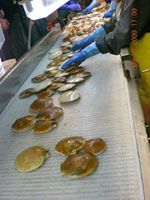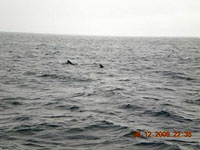

 | |||||||||||||||||
|
|
Journals 2009/2010Beth Brocato
September 12, 2009 Check my location here. OK - so here is my Saturday. We finally left Newport at 9 a.m. I was vomiting by 10:30 a.m. Never far from a bathroom. Then we had to do drills. Fire drill is just at a meeting spot. Abandon Ship drill is full-on gear. Just like the gumby suits on Deadliest Catch. They are not easy to get into. Spent the rest of the day in bed. The ship was to take 18 hours to get to the first station. I skipped lunch, and weakly attempted dinner. Went back to bed. Got a wake-up call at 11 p.m. By wakeup, I mean someone knocks on your door, comes in your room, and says "Wake Up Beth!" We had to be in the wet-lab by midnight. We are on this watch until noon and we were able to complete four trawls.
The second and third trawl stations were full of scallops. We had to measure the length of each scallop in 30 bushels (about 800 kilograms). Did you know that most scallops have between 40 and 60 eyes!
In between trawl events we would clean down the lab, read, grab a snack, and go on deck to watch for whales. We got lucky this morning and saw a small pack of pilot whales swim by the boat.
After a good cleaning of the wet lab, we were dismissed to lunch and then all of the team members on this watch went to bed. More trawling tomorrow! QUESTION: How many eyes does a sea scallop have? |
||||||||||||||||



